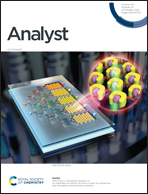Analysis of 1-aminoisoquinoline using the signal amplification by reversible exchange hyperpolarization technique†
Abstract
Signal amplification by reversible exchange (SABRE), a parahydrogen-based hyperpolarization technique, is valuable in detecting low concentrations of chemical compounds, which facilitates the understanding of their functions at the molecular level as well as their applicability in nuclear magnetic resonance (NMR) and magnetic resonance imaging (MRI). SABRE of 1-aminoisoquinoline (1-AIQ) is significant because isoquinoline derivatives are the fundamental structures in compounds with notable biological activity and are basic organic building blocks. Through this study, we explain how SABRE is applied to hyperpolarize 1-AIQ for diverse solvent systems such as deuterated and non-deuterated solvents. We observed the amplification of individual protons of 1-AIQ at various magnetic fields. Further, we describe the polarization transfer mechanism of 1-AIQ compared to pyridine using density functional theory (DFT) calculations. This hyperpolarization technique, including the polarization transfer mechanism investigation on 1-AIQ, will provide a firm basis for the future application of the hyperpolarization study on various bio-friendly materials.



 Please wait while we load your content...
Please wait while we load your content...